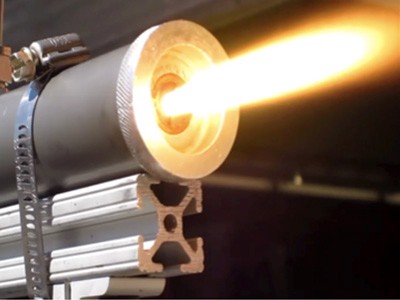GOX and Nitrox Hybrid Green Rocket System
A “green” hybrid rocket thruster has been devised by USU researchers as an alternative to more commonly used propellants such as the monopropellant hydrazine and cold gas thrusters. In addition to providing excellent control of the ignition system, the hybrid rocket thrusters provide the safety and simplicity offered by cold gas thrusters, while simultaneously providing specific impulse values comparable to hydrazine thrusters.
Problem
Previously, on-demand ignition thruster systems have been unreliable, which is why small-scale hybrid rockets have received little consideration for in-space propulsion. Thruster systems currently used with small satellites include hydrazine-based systems, and cold gas systems. Cold gas thrusters typically use an inert gas, and function by expelling pressurized gas in the direction opposite of the desired movement. Because the gas is usually unheated, expulsion speed is relatively low and low performance is achieved. Cold gas systems are simple and inexpensive, but low performing. Hydrazine based thrusters have high performance. However, hydrazine is highly toxic and dangerously unstable when not in solution.
Solution
Researchers at USU have developed a novel on-demand ignition system, which can be reliably controlled. The system consists of a 3-D printed acrylonitrile butadiene styrene (ABS) matrix combined with an oxidizer of either gaseous oxygen (GOX) or an enriched air mixture (Nitrox). In the system, unique electrical breakdown properties of the ABS matrix are exploited so that spontaneous combustion occurs at desirable local oxygen partial pressures. USU researchers have also developed a method of reducing the required volume of high-pressure Nitrox by more than 30% through the addition of certain elements to the ABS matrix.
Benefits
The ABS/Nitrox system has the potential to offer the simplicity and safety of a traditional cold gas system while providing a factor of performance increase of characteristic velocity up to 340%. The specific impulse of the thrusters also exceeds that of hydrazine-based systems.
Applications
This technology is ideal for government agencies and other entities looking to replace hydrazine-based propulsion systems. This technology proposes major valuable improvements in that the propulsion system is powerful, safe, efficient, and non-toxic.

Contact
Questions about this technology including licensing availability can be directed to:
Alan Edwards, MA, JD
Manager, Technology Transfer Services
(435) 797-2328 alan.edwards@usu.edu
Inteum ID C18052
Inventors
Stephen Whitmore, Ph.D.
Mechanical and Aerospace Engineering
Zachary Lewis
Aerospace Engineering Graduate Student
Anthony Bulcher
Engineering Graduate Student
Development Stage
TRL 4
Patent Status
Patented

